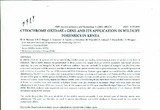Cytochrome oxidase 1 gene and its application in wildlife forensics in Kenya

Date
2013Author
Mururu, MM
Muigai, AWT
Kimwele, C
Gatebe, E
Kinuthia, J
Mwaniki, M
Gakuya, F
Kwamboka, E
Mbugua, D
Type
ArticleLanguage
enMetadata
Show full item recordAbstract
In African countries in general and Kenya specifically, wildlife crimes are leading an increasing number of species to the brink of
extinction. This is partly because the perpetrators of these crimes once caught don't get severely punished. Appropriate penalties
matching the crime are hampered by lack of sufficient evidence. Accurate methods for analyses of biological samples from crime
scenes and confiscated wildlife products in order to determine their species identity and origin are necessary for successful prosecution
and conviction of poachers. The use of Mitochondrial DNA (Cytochrome Oxidase) gene region) is a useful tool for wildlife species
identification. The CO) is a gene region that is approximately 648 base pairs long and is present in all Eukaryotes.This study validated
the use of CO) gene in wildlife species identification. Wildlife samples from six animal species namely Blue Wildebeest, Grevy Zebra,
Thomson's Gazelle, Lesser Kudu, Impala and Maasai Giraffe. were collected using Biopsy darts from various wildlife reserves and parks
in Kenya. 100 samples from meat markets in Laikipia County were also obtained to investigate illegal bush meat trade and meat
substitution in the County. DNA was extracted from all the samples and the CO) gene amplified through Polymerise Chain Reaction
(PCR). The PCR products were sequenced and their sequence similarity with other sequences in Barcode of Life Database (BOLD)
determined using BLAST analysis.
The results showed that CO) gene identified all the wildlife samples accurately. It also showed cases of domestic species meat
substitution. The gene can therefore be used in species identification and a CO) database in Kenya would be very useful in
conservation efforts.
Publisher
University of Nairobi
Description
Journal Article
